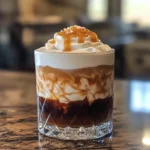Ingredients
A great cocktail is more than the sum of its parts, but understanding each component is the first step toward mastery. Each element in the Salted Caramel Butterscotch White Russian has a specific role to play in the symphony of flavor.
The Foundation: Vodka
Vodka serves as the silent, strong backbone of this cocktail. Its primary job is to provide an alcoholic kick without imposing a dominant flavor of its own. A high-quality, neutral vodka is ideal here. You don’t need an ultra-premium, small-batch bottle, but you should avoid anything with a harsh or chemical aftertaste. The vodka’s clean profile allows the more expressive ingredients—the butterscotch, coffee, and caramel—to take center stage. It is the canvas upon which the other flavors are painted.
The Warm Embrace: Butterscotch Schnapps
This is the ingredient that definitively separates this cocktail from its classic predecessor. Butterscotch schnapps introduces a deep, rich, and uniquely warm sweetness. But what exactly is butterscotch? True butterscotch is a confectionery made by slowly heating brown sugar and butter, and that essence is captured in the liqueur. Its flavor profile is often described as warmer and richer than caramel, which is typically made from white sugar. The introduction of butterscotch schnapps adds a creamy, buttery depth that complements the coffee notes beautifully, creating a foundation that is reminiscent of a rich, buttery toffee.
The Robust Heart: Coffee Liqueur
The non-negotiable soul of any White Russian variation is a good coffee liqueur. Brands like Kahlúa are the standard for a reason. It brings the essential, bitter, and aromatic notes of coffee that cut through the sweetness of the other components. The complexity of coffee—with its inherent notes of chocolate, nuts, and roasted beans—provides a necessary counterbalance. Without it, the drink would be cloyingly sweet. The coffee liqueur grounds the cocktail, giving it a sophisticated edge and a caffeine kick that makes it the perfect after-dinner drink.
The Velvet Curtain: Heavy Cream or Milk
The cream is responsible for the cocktail’s luxurious mouthfeel and iconic appearance. Heavy cream (or whipping cream) is the traditional and most indulgent choice. When poured gently, it floats on top of the denser spirits, creating a striking visual contrast and a textural journey. As you sip, the cream slowly integrates, mellowing the alcohol and creating a smooth, unified whole. For a slightly lighter version, whole milk can be used. It will still provide creaminess but with a less rich texture. The choice between cream and milk allows you to customize the drink’s decadence to your personal preference.
The Star of the Show: Salted Caramel Sauce
While butterscotch schnapps provides a foundational sweetness, the salted caramel sauce is the feature performer. It does two critical things. First, it reinforces the caramel notes, adding a layer of pure, sugary richness. Second, and more importantly, it introduces salt. Salt is a flavor enhancer; it has the magical ability to make sweet things taste even sweeter while simultaneously preventing them from being overwhelming. The tiny crystals of sea salt in a good-quality salted caramel sauce will pop on your tongue, creating a dynamic and complex flavor profile that keeps you coming back for another sip. This salty-sweet combination is the hallmark of modern gourmet desserts and it works exquisitely well in a cocktail format.
Instructions
Crafting this cocktail is a simple process, but attention to detail will elevate your result from a good drink to a great one.
Step 1: The Preparatory Stage
Before you even touch your spirits, consider your glassware. A robust, short tumbler, often called an Old Fashioned or rocks glass, is the ideal vessel. Its wide brim is perfect for an optional salted caramel rim, which we highly recommend. To create the rim, take a small amount of your salted caramel sauce and spread it in a thin layer on a small plate. On a separate plate, spread a layer of flaky sea salt. Take your empty glass and gently press the rim first into the caramel, twisting to ensure an even coat, and then into the sea salt. This not only creates a professional presentation but also ensures that your first and last sips are punctuated with that essential salty-sweet crunch.
Step 2: The Chilling Phase
Fill your prepared glass with fresh, high-quality ice. Avoid using ice that has been in the freezer for months and has absorbed other odors. The ice should be clear and cold. Filling the glass now, before adding the liquids, prevents excessive and messy overflow.
Step 3: Combining the Core Spirits
There are two schools of thought here, each yielding a slightly different result. The direct method involves pouring the one ounce each of vodka, butterscotch schnapps, and coffee liqueur directly over the ice in the glass. This is quick and efficient. The alternative method is to add these three ingredients to a cocktail shaker filled with ice. Shake vigorously for 10-15 seconds and then strain the mixture into your ice-filled glass. This method has distinct advantages: it chills the liquids more rapidly and thoroughly, and it creates a slight dilution that can actually help open up the flavors and soften the alcoholic bite, resulting in a smoother integration.
Step 4: Incorporating the Caramel and Cream
Once your spirit base is in the glass, add a generous drizzle of the salted caramel sauce. Now, for the pièce de résistance: the cream. To achieve the classic layered look, you must pour the cream slowly and gently over the back of a spoon held just above the surface of the liquid. This technique disperses the flow of the cream, allowing it to float on top of the denser cocktail base. For the signature “swirling effect” mentioned in the recipe, you will then take a stirrer or a thin spoon and give the drink one or two very gentle stirs. The goal is not to homogenize the drink, but to create beautiful, marbled streaks of cream weaving through the dark, rich base.
